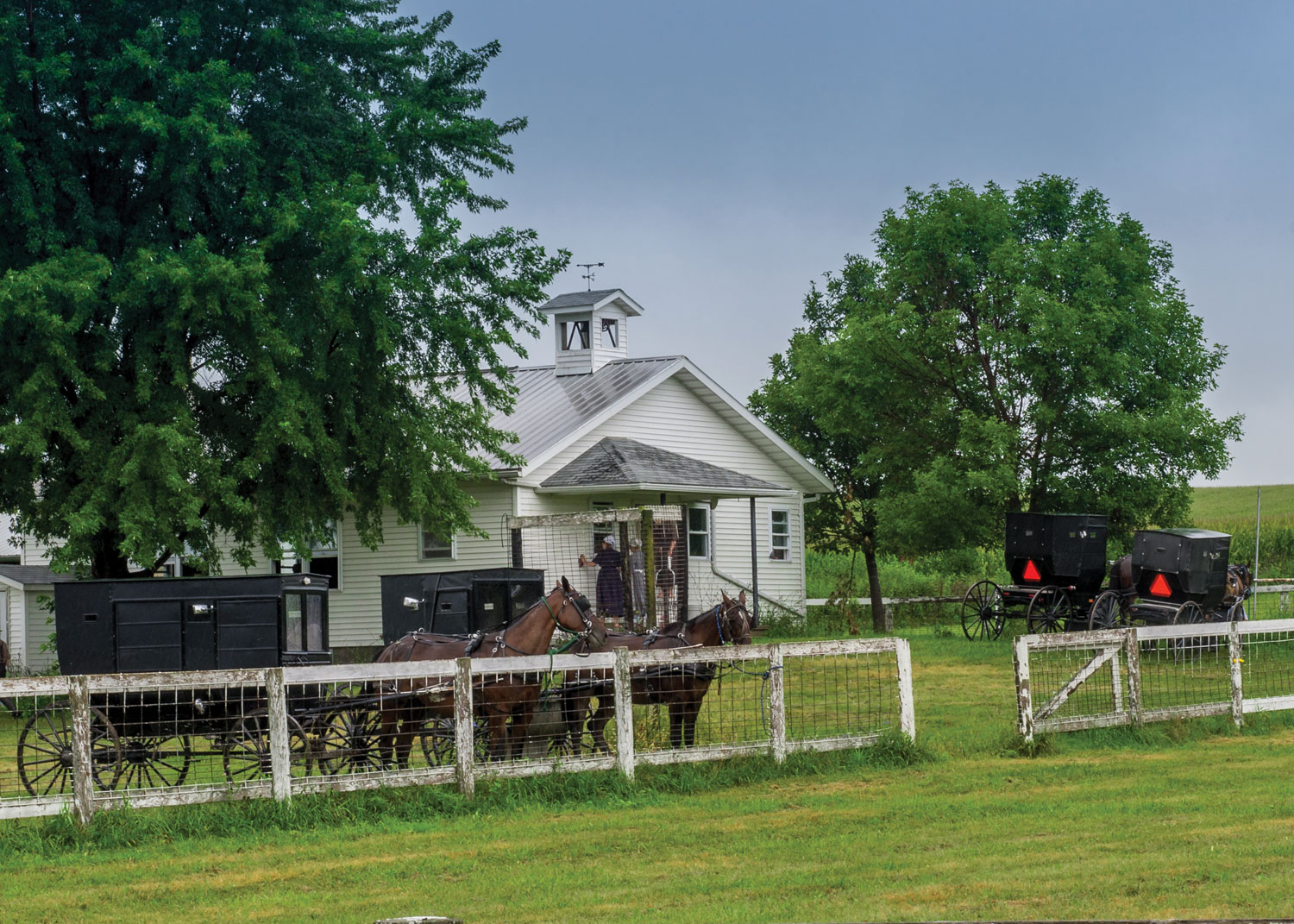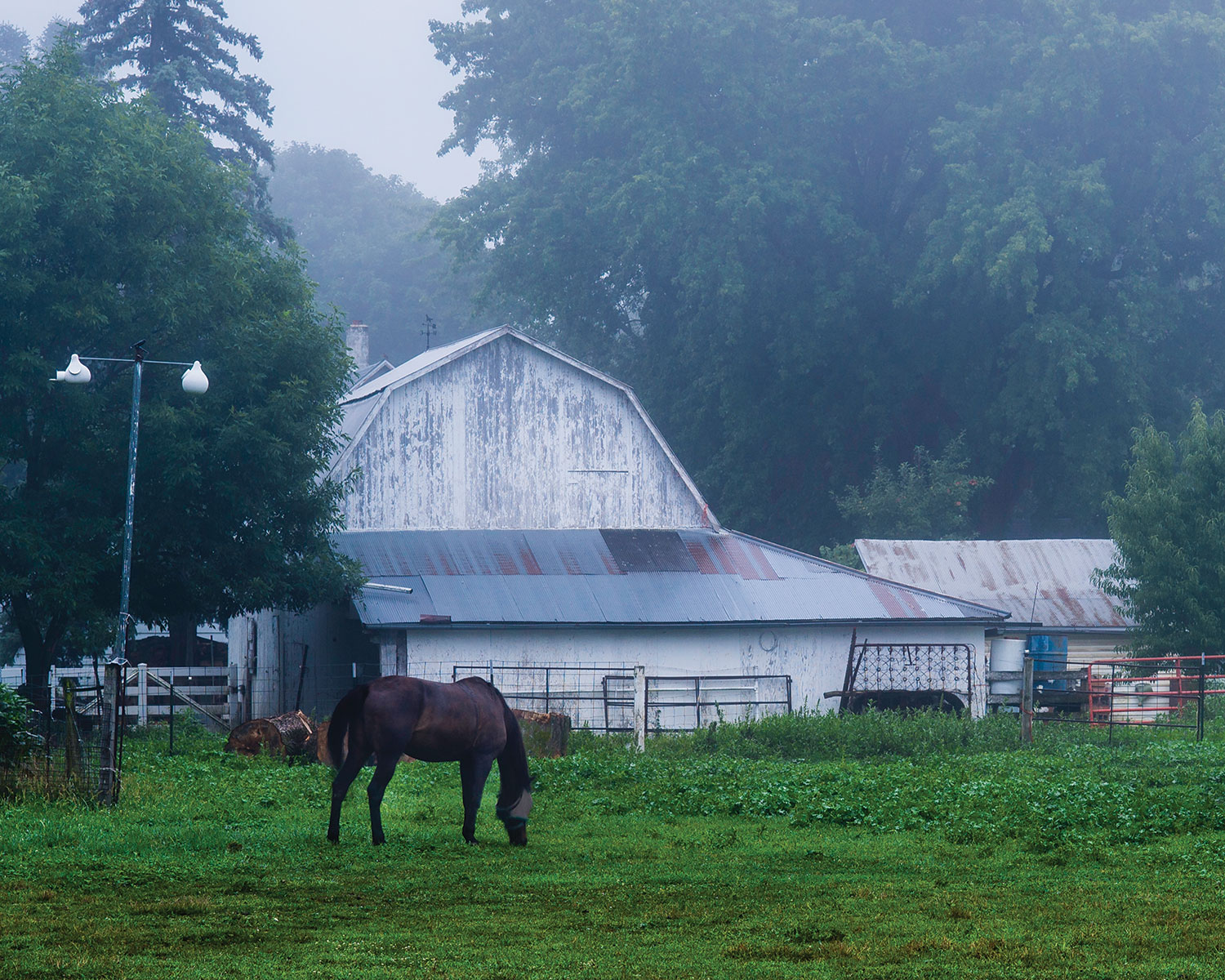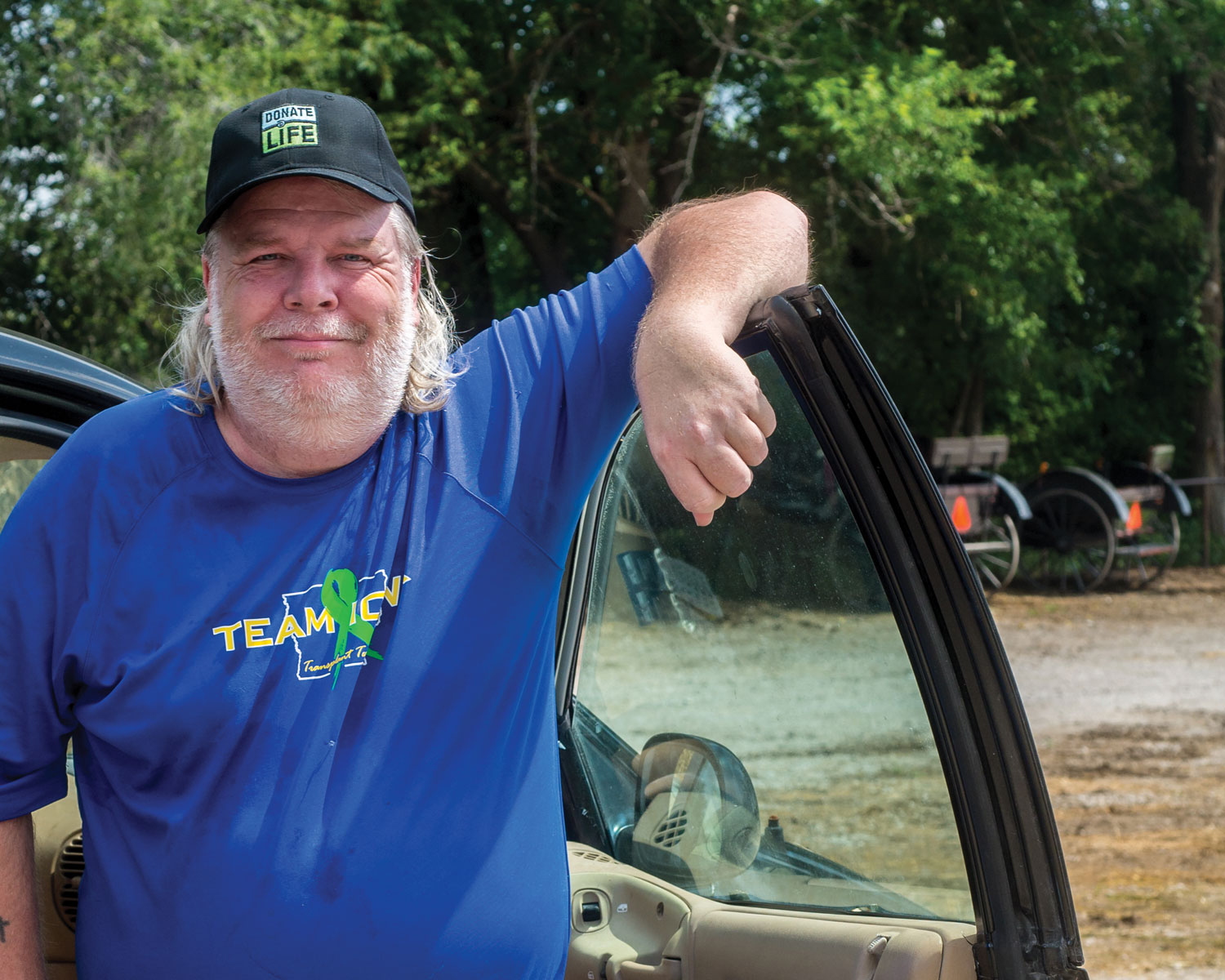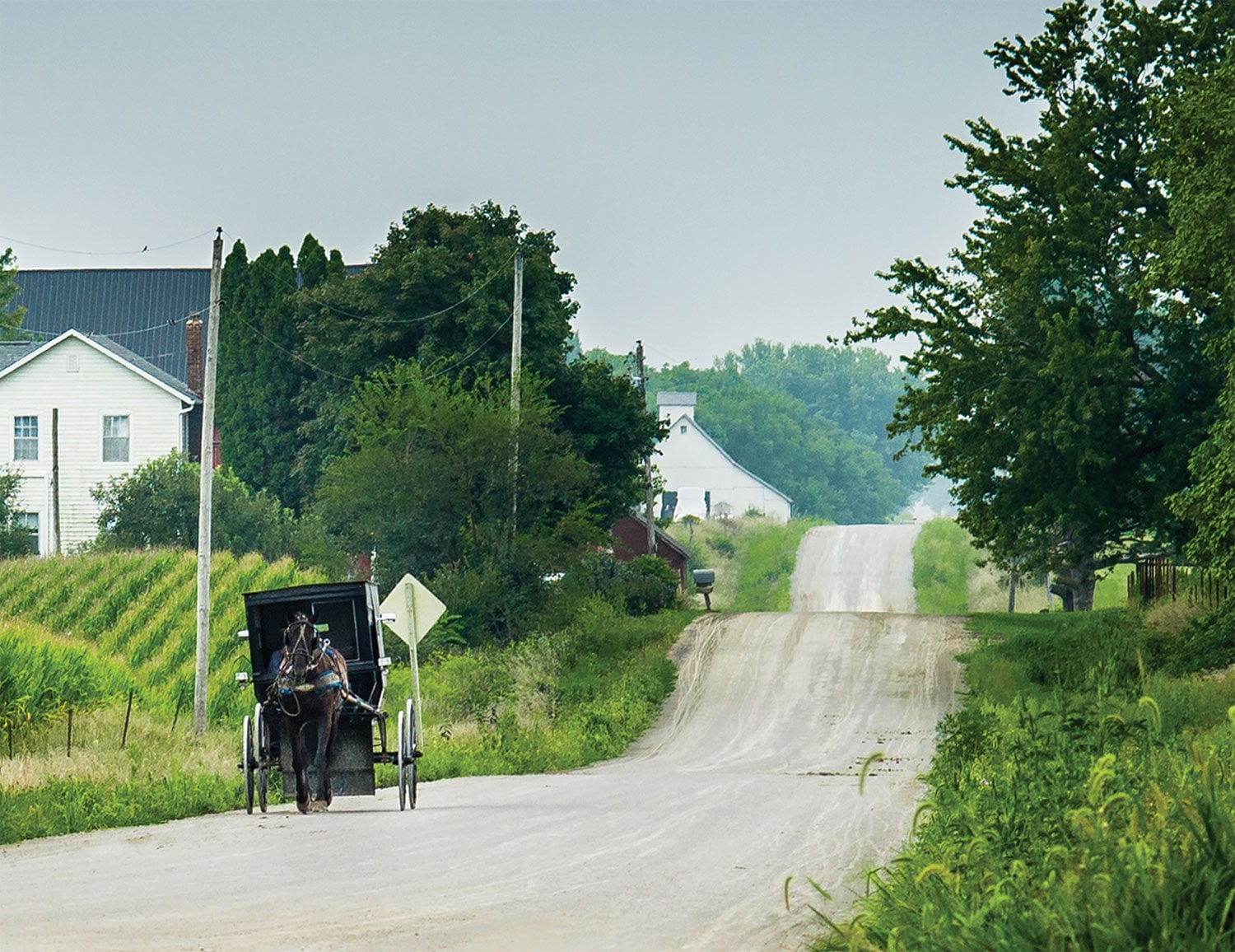WHEN ELSON MILLER, a 53-year-old farrier living in Kalona, Iowa, led me into his family’s home to meet his wife, Loretta, I smelled the sweet aroma of cinnamon and apples. In the basement, I came upon tables filled with warm jars of homemade applesauce. Loretta, 49, stood by the stove boiling down a pot of apple skins and flesh, turning frequently to mash chunks of fruit cooling in a colander. At one end of a table sat a stack of quilting squares that Loretta said she was “cutting during slow times” between batches. It was in this welcoming, bustling space that Elson, Loretta and I talked about Loretta’s experiences with stage I pleomorphic spindle cell sarcoma, a rare soft-tissue malignancy.
As a cancer survivor myself, I traveled to rural Kalona in August 2018 to learn more about how members of an Old Order Amish community respond when cancer affects one of their own. Kalona, in eastern Iowa, has just over 2,500 residents. Between 1,200 and 1,500 of them are Amish, a Christian sect known for living apart from the world and eschewing many of its technologies. Most of the Amish make a living from farming and a mix of carpentry and other traditional trades, and their children usually attend Amish-only schools. During my brief visit, several Amish families invited me into their homes to share their experiences with cancer and medicine. I was not surprised to discover a deep commitment to God among those I met, but I was less prepared for the resourcefulness and openness to modern medicine displayed by Amish families in responding to cancer. The individuals I met were open to benefiting from modern medicine, while also placing their trust in home remedies, herbs and vitamins.

Children in Amish communities usually attend Amish-only schools like the one shown above. Photo by Doug Bergeron
Putting It in God’s Hands
“Once the shock of the diagnosis sinks in, then you submit to the Lord’s will.” —Elson Miller
Recounting the specifics of her December 2005 diagnosis, Loretta told me how the discovery of cancer coincided with happier news: the impending arrival of their youngest son Dwight. Loretta’s doctor first identified a lump in her groin during an ultrasound scheduled to address a blood clot that had formed just a few weeks prior to Dwight’s birth. A surgeon removed the lump at Washington County Hospital in the nearby town of Washington seven weeks after Dwight was born. Elson told me he was shocked by the doctor’s abruptness in communicating the diagnosis, knowing that Loretta was still recovering from the delivery while caring for their newborn boy.
“The doctor came in right after surgery—he was a young doctor—and said, ‘Well, it’s cancerous,’” Elson recalls, adding that he and Loretta had to “wait in suspense for 18 more days until it was confirmed and we got the test results” from pathology.
“With my oldest [daughter] Elnora in the eighth grade and four preschoolers at home, I thought, how will I raise them?” says Loretta, her voice quavering while reflecting on her feelings at the time. “How will Elnora, who’s just 14, teach the others to sew, can [fruits and vegetables], do the things they need to know? They’re not ready. They are too young for me to leave them.”

The Amish are known for living apart from the world in rural areas like this one in Kalona, Iowa. But they are open to using modern treatments for cancer when necessary. Photo by Doug Bergeron
Eventually the cancer was classified as stage I, meaning it was contained to the nerve sheath inside her groin and hadn’t spread to other parts of her body. Still, Elson and Loretta had to travel daily for more than five weeks to Mercy Hospital in Iowa City, about 20 miles from Kalona, for radiation treatments while tending to their newborn son and eight other children. After the treatments ended, Loretta struggled with extreme pain and scarring, as well as partial paralysis in her right leg caused by a damaged nerve.
“It took me three years to get [the use of] my leg back,” Loretta said. “I kept walking, pushing myself. It was willpower and faith in God that got me through.”
Learn more about how the Amish approach cancer.
There are few scientific studies on cancer among the Amish due to limited access to community members and a lack of accurate data on cancer incidence, treatment and mortality. However, some information is available:
- A 2010 study published in Cancer Causes and Control revealed the low incidence of cancer among the Amish in Ohio during a seven-year period. The findings suggest that healthy behaviors of Amish people—including minimal tobacco and alcohol use, limited sexual partners, and physical exercise—pay off in lower cancer incidence, despite fewer visits to health care professionals for screening and the presence of certain genetic disorders.
- A 2009 study published in the Online Journal of Rural Nursing and Health Care compared the use of complementary and alternative medicine among Amish and non-Amish people living in Ohio.
- For an effective overview of approaches to health and health care among the Amish and other cultures, see Transcultural Health Care: A Culturally Competent Approach by Larry Purnell and Betty Paulanka. An engaging and informative book, 99 Favorite Amish Home Remedies by Georgia Varozza, is also worth a look.
- To learn more about the Amish approach to health and the lifestyles they embrace, read Sara Talpos’ article in Quartz called “The Amish Understand a Crucial Thing About Modern Medicine That Most Americans Don’t” and Jeffrey Kluger’s column in Time “Amish People Stay Healthy in Old Age. Here’s Their Secret.”
Seeking Care When Needed
“God made our bodies to heal, [to] take care of themselves.” —Herman Yoder
When members of the Amish community in and around Kalona experience illness, some head first to the home of Herman Yoder, 70, and his wife of three years, Emma Grace, 53. Yoder was able to avoid military service during the Vietnam War because the Amish are pacifists; a government program allowed him to work as an orderly in the emergency room of an Oklahoma hospital instead of joining the armed forces. Today, he applies what he learned during his two-year hospital stint, as well as years of caring for his late wife who suffered from rheumatoid arthritis, to benefit his Amish neighbors.
“I got my education in the basics of home remedies, treating cuts and bruises, taking vitals, determining serious and less urgent cases through on-the-job ‘classes’ from 1969 to 1971,” Yoder says. “I learned to rely on my experiences, the school of hard knocks, to teach me what I know about health and illness.” Yoder adds that he continued to learn while caring for his late wife.
Despite having only an eighth-grade education, he is referred to as “Dr. Yoder” by many of the Amish who seek his guidance. From his home, he suggests simple remedies for common maladies. He also acts as a health adviser, noting individuals’ symptoms and urging them to see a medical professional when it’s necessary. For Kalona residents, that usually means a visit to Mercy Hospital or University of Iowa Hospital, both in Iowa City, for more extensive testing or procedures.

Myron Thirtle drives the Amish to destinations that are beyond the reach of a horse-drawn buggy. Photo by Doug Bergeron
Some members of the Amish community—like some non-Amish cancer patients—seek a mixture of alternative therapies and standard care. In August 1980, Verna Bender, now 63, noticed lumps on the side of her neck while she was breastfeeding her second child. The doctor at a local clinic examined her neck and scheduled a chest X-ray for the following day to look for evidence of the source.
“When [Verna] came home from that doctor, she had quite a load to carry,” says her husband, Perry, 63, describing the emotions Verna experienced after going to the doctor alone. Results from a chest X-ray at Mercy Hospital and a CT scan at University of Iowa Hospital led to a diagnosis of sorts. According to Perry, the doctor wouldn’t give them a clear answer about what Verna was dealing with.
“The doctor said she had Hodgkin’s disease, that it was a malignancy of the lymph gland, was treatable, curable, but wouldn’t use the word ‘cancer,’” Perry says. “I don’t know why [the communication] couldn’t be more direct.”
Disenchanted by what they perceived as a slow pace in determining Verna’s treatment, the couple turned to a doctor in Kentucky, who offered an alternative approach to treating Verna’s cancer that included colon cleansing and a carrot juice regimen. By December 1980, Verna had become “skin and bones,” according to Perry, and was having trouble swallowing. A return trip to University of Iowa Hospital in January 1981 revealed that his wife had a bulge on her collarbone and was experiencing stage IV, or metastatic, Hodgkin lymphoma. The doctor recommended six months of chemotherapy.
Verna remained symptom-free for decades following her treatment and gave birth to seven more children, despite an oncology nurse’s warning that the chemotherapy might leave her infertile. In January 2016, Verna was diagnosed with stage II sigmoid colon cancer and underwent several rounds of what Perry called “mild chemo” from January through August at St. Luke’s Hospital in Cedar Rapids, Iowa. After becoming frustrated with the pace of Verna’s care at St. Luke’s, the couple traveled to a hospital in Tijuana, Mexico, where Verna was treated with surgery and chemotherapy. Although she has had several benign polyps detected and removed from her colon at Mercy Hospital since her return, she has had no recurrence of colon cancer for more than two years.
The Amish use a variety of methods to travel to medical appointments.
- Amish people may travel by car, van, bus or train if the vehicle is operated by a non-Amish driver. For example, the Benders, a couple who sought treatment in Mexico, traveled by hired car to Mount Pleasant, Iowa, 45 miles from Kalona. From there, they rode Amtrak trains to San Diego. They were transported by car to Tijuana, Mexico, by representatives from the facility where Verna Bender’s colon cancer was treated.
- Old Order Amish are not allowed to fly except in emergency situations, for example, if an airlift is needed to quickly transport an individual in critical condition to another hospital.
- Phone shacks—locations where church members can place or receive calls—are available for individuals seeking transportation. The Budget, a publication for the Amish and Mennonites, runs ads for transportation and ride-sharing services. Thirtle says members can also use what he calls an Amish hotline to get transportation and to be connected with other Amish people heading in a similar direction who might be willing to share the cost of a ride.
Living a Healthy Life in Community
“We believe we should rely on our family and community to help us through an illness.” —Elson Miller
In the home of Henry and Mary Swartz, where I stayed during my visit, I noticed a number of books and pamphlets about how to maintain good health and prevent disease. In a small store behind their house, the couple offers publications about health and a selection of foods and dietary supplements. The store also provides locally made cheeses, homemade breads and produce from their garden.
Physical fitness is the norm for most Amish in Kalona, due in part to a lifestyle that requires daily physical labor. The Amish are expected to abstain from drugs, alcohol and tobacco, and their diet typically consists of organic meats, fruits and vegetables.
My peek inside the lives of Old Order Amish families in Kalona revealed people who put a priority on God, family and community. While their choices might be considered “plain,” in keeping with their Amish values, the individuals I met understood their bodies and the ways cancer affected their lives. They respected the care available through modern medicine while embracing traditional practices.
Each culture brings a unique perspective to health and illness.
After being diagnosed twice with breast cancer in 1993 and 2004, I thought I knew just about everything about living with cancer. But my travels to Kalona, Iowa, where I spent time talking with members of an Old Order Amish community who have experienced cancer, taught me that each culture brings a unique perspective to health and illness. Here are five lessons I took away from our conversations.
- Faith matters. Those facing cancer and their loved ones rely on the spiritual principles that form the basis of their lives. Following the initial shock of a cancer diagnosis, the Amish turn to their faith to guide their journey.
- Community matters. As Elson Miller, whose wife, Loretta, was diagnosed with stage I pleomorphic spindle cell carcinoma, told me, “We trust our community to help us through illness.” The community offers emotional strength, practical assistance with everything from child care to cooking and cleaning, and, if needed, financial support for medical bills.
- Persistence matters. Members of the community often show a willingness to seek second opinions from physicians and to consider alternative cancer treatments and health care facilities. They base medical decisions on criteria including perceived timeliness and practicality and what they believe to be the soundness of the therapy.
- Openness matters. Both the healthy and the sick embrace a combination of modern medical treatments and natural home remedies including herbs, vitamins, salves and compresses made from the leaves of local plants. Many of these homemade preparations are passed down from one generation to the next.
- Industriousness matters. I observed that the Amish in Kalona constantly stayed busy. As we talked about their encounters with cancer, women broke beans, cracked hickory nuts, or cut squares of fabric for their next quilting project. Men kept one eye on the milking of their goats or the shoeing of a neighbor’s horse while engaging in conversation. This same industriousness—the commitment to steady, productive activity—was evident in how members of the community faced cancer when it affected them or their neighbors.
I asked them how cancer survivors, or any community members facing expensive medical bills, were able to pay for their care. The Amish do not contribute to or benefit from Social Security or Medicare, and they also don’t purchase private health insurance or receive it through an employer.
Some of the leading members of the Kalona Amish community serve as liaisons between the Amish and representatives of local health care facilities. They negotiate the amounts families pay and help to set up plans that allow them to spread out their payments. Several people I spoke to said they often paid reduced costs similar to what insurance companies would offer medical facilities for their services.
“We take care of our own,” Elson Miller says of the support the Amish provide to one another, adding that the church helps when it’s needed. “If we don’t help our friends and neighbors and church members, then who would we be willing to help?”
Cancer Today magazine is free to cancer patients, survivors and caregivers who live in the U.S. Subscribe here to receive four issues per year.





